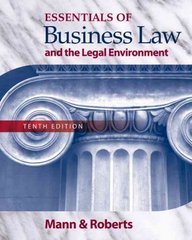Question
A monopolist has the cost function c(y) = 100y. Assume that there is only one type of consumers, A, described by the inverse market demand
A monopolist has the cost function c(y) = 100y.
Assume that there is only one type of consumers, A, described by the inverse market
demand function pA = 10, 000 2QA, where QA denotes market quantity and pA market
price.
a) Find the total revenues, total costs and total profits of the monopolist if she is charging
a uniform price. (1 mark) Find consumer's surplus (0.5 mark) Is there any deadweight
2
loss in this situation? If yes, calculate the deadweight loss. If no, explain why the
outcome is Pareto efficient. (1 mark)
b) Find the total revenues, total costs and total profits of the monopolist if she can practice
First-Degree Price discrimination. (1 mark) Find consumer's surplus (0.5 mark) Is
there any deadweight loss in this situation? If yes, calculate the deadweight loss. If no,
explain why. (1 mark)
Now assume that there is an additional group of consumers, Type B, which are described by
the market demand function pB = 5, 000 2QB.
c) Assume that the monopolist is charging a uniform price to the whole market, composed
now of A and Type B consumers. Specifically, the market demand is now
p(Q) = pA + pB, where Q = QA + QB (i.e. total output sold to all consumers). Find
the total revenues, total costs and total profits of the monopolist. (1 mark)
d) Assume that the monopolist can practice First-Degree price discrimination over the
whole market, composed now of A and Type B consumers. Find the total revenues,
total costs and total profits of the monopolist for each type of consumer (2 marks)
What is consumers' surplus for A consumers? (0.5 mark) What about Type B
consumers? (0.5 marks)
e) Suppose now that the monopolist can practice second-degree price discrimination.
Discuss what happens to the monopolist profits for each type of consumer relatively to
part d) above. (0.5 marks) How much quantity do A consumers buy, and how
much do Type B consumer buy, compared to part d) ? (0.5 marks) What happens to
consumers' surplus for A consumers compared to part d)? (0.5 marks) What
about consumers surplus for Type B consumers relatively to part d) ? (0.5 marks) Is
the outcome Pareto efficient for A consumers? (0.5 marks) Is the outcome Pareto
efficient for Type B consumers? (0.5 marks)
Step by Step Solution
There are 3 Steps involved in it
Step: 1

Get Instant Access to Expert-Tailored Solutions
See step-by-step solutions with expert insights and AI powered tools for academic success
Step: 2

Step: 3

Ace Your Homework with AI
Get the answers you need in no time with our AI-driven, step-by-step assistance
Get Started


